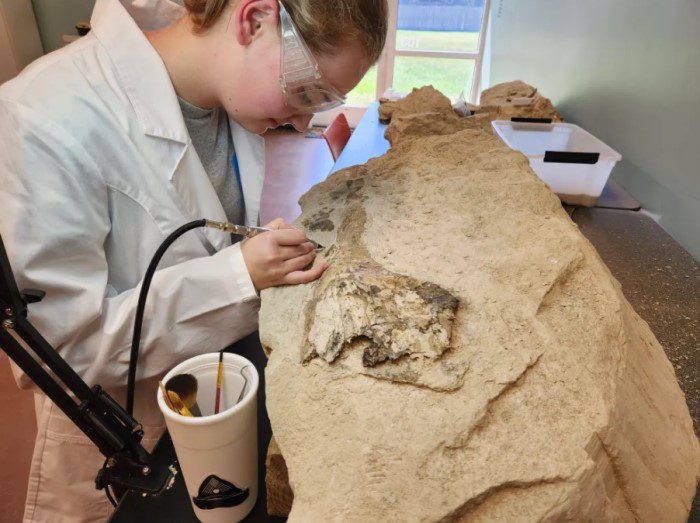An Alabama teenager got an early start on a career in paleontology.
At only 16 years old, Lindsey Stallworth has already found a 34-million-year-old whale fossil!
The fossil was found on her family's timber farm in Monroe County in Alabama. How is that for playing in the backyard? Though today the area is dry land, millions of years ago, this part of the world was covered by a shallow sea.
That makes it the perfect location for sea fossils of all kinds—from shark teeth and sea shells to the bones of massive ocean predators!
Follow the trail

Andrew Gentry and Lindsey Stallworth pose with the whale skull fossil. They had wrapped it in plaster for protection. (Alabama School of Mathematics and Science)
Stallworth made the find with the help of Andrew Gentry, who is a paleontologist and teacher at the Alabama School of Mathematics and Science. The pair were looking to find fossils as part of a summer school project.
At first, they noticed a trail of small bone fragments. But after following them uphill, they were startled to discover a very large, mysterious bone.
The pair spent the next few days patiently working to expose more and more of the fossil until they found a tooth. After this, Gentry was able to send photos of the fossil for analysis. The conclusion?
He and Stallworth had found the jawbone of a large, prehistoric whale!
A new species?

Stallworth works on cleaning the fossil in a lab. (Alabama School of Mathematics and Science)
The pair have now fully removed the rock containing the jawbone. Overall, the bone measures over a metre (about four to five feet), meaning the animal's overall length could have been 15 metres (50 feet) or more!
Based on its teeth, they believe that the animal belonged to the Basilosauridae family, an extinct group of carnivorous whales. Basilosaurs were long and lizard-like. In fact, the name means "king lizard"!
But unlike prehistoric sea predators such as mosasaurs, these beasts were not reptiles. They were mammals—the ancestors of modern cetaceans (whales). The fossil Stallworth and Gentry found may even be a species unknown to science. Only time—and further research—will tell.
This is why the pair plan to return next year to extract more of the fossil. Gentry believes that there may be a nearly complete fossil hidden within the rock. Complete fossils are very rare in paleontology.
What an incredible way for Stallworth to start her paleontological career!
 Lindsey Stallworth works to expose a rare whale skull fossil. (Alabama School of Mathematics and Science)
Lindsey Stallworth works to expose a rare whale skull fossil. (Alabama School of Mathematics and Science)









I think that it’s so cool that there might be a whole whale under the rock.